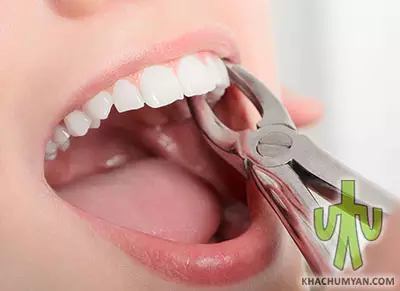 Nowadays, any self-respectful clinic uses effective painkillers that allow all procedures, including tooth extraction, to be completed without pain. Any educated doctor will introduce to you all the negative aspects of tooth extraction and the methods to avoid those negative aspects. One of the methods is dental implantation. After the tooth extraction, a large defect emerges. The adjacent teeth bend over the defected place throughout time, trying to cover it. To avoid all this and not to elaborate the adjacent teeth, an implant is placed. The other method is fixed prosthetics, during which the adjacent teeth are elaborated, as a rule, depulpated.
Nowadays, any self-respectful clinic uses effective painkillers that allow all procedures, including tooth extraction, to be completed without pain. Any educated doctor will introduce to you all the negative aspects of tooth extraction and the methods to avoid those negative aspects. One of the methods is dental implantation. After the tooth extraction, a large defect emerges. The adjacent teeth bend over the defected place throughout time, trying to cover it. To avoid all this and not to elaborate the adjacent teeth, an implant is placed. The other method is fixed prosthetics, during which the adjacent teeth are elaborated, as a rule, depulpated.
What relates to the tooth extraction process, if the doctor is literate and experienced, and the patient is careful and retrospective, as a rule, there are no complications.
Indications to tooth extraction

Tooth extraction is a radical approach to the problem-solving process. Unfortunately, there are many cases when the tooth is in such a condition that it is not possible to treat it conservatively and the only option is tooth extraction.
- Wisdom teeth that are in the wrong position, cause mucosal damage and have a bad effect on the biting system
- Periodontitis that cannot be treated with therapy or surgery
- A damaged tooth or root that cannot be recovered orthopedically
- In case of wrong biting system, the tooth is sometimes removed, which hinders the restoration process
- In case of a jaw fracture, the teeth that are in the fracture line have to be removed
- Root caries is an indication for tooth extraction
- Third-grade mobility
- Tooth fracture emerged because of trauma
- Exposure of root bifurcation
Contraindications to tooth extraction
Contraindications are relative depending on the patient's condition.
- Mental disorders in the exacerbation phase
- Cardiovascular and renal diseases in the exacerbation phase
- Infectious hepatitis in the acute phase
- Hemorrhagic diathesis
- Infectious diseases of the respiratory system
- The first and last trimester of pregnancy. First, second and ninth months are considered the most dangerous.
Painless dental extraction
 Due to the good anesthetic substances, tooth extraction is performed under local anesthesia. Depending on the patient's health, adrenaline containing or non-adrenaline anesthetic may be used.
Due to the good anesthetic substances, tooth extraction is performed under local anesthesia. Depending on the patient's health, adrenaline containing or non-adrenaline anesthetic may be used.
It is common to distinguish three degrees of difficulty of dental extraction:
1. Simple
2. Medium
3. Complicated
Belonging to this or that group depends on many factors such as the anatomy of the tooth, the number and form of the roots or whether the tooth has completely appeared, or it is is still in the bone or is in the level of the gums. Another factor is to what degree has the tooth been treated before. All this makes the work hard and increases the possibility of complications.
After the tooth extractions, the doctor prescribes the appropriate treatment and gives instructions that the patient must follow exactly, otherwise many difficulties are possible.
Tips after tooth extraction

- Do not eat for 2 hours after tooth extraction
- Do not rinse your mouth to maintain blood circulation. An antiseptic liquid can be kept in the mouth
- Do not heat the area of the removed tooth and do not sleep on that side
- Apply ice to the extracted tooth for 10 minutes at 15-minute intervals. All this is done so that it does not swell after a difficult removal
- Do not have a bath in hot water for several days
- Do not do sports or hard physical work for a few days
- Do not drink alcohol and avoid smoking as much as possible
- See a doctor on the appointed day, and time even if nothing is bothering you
These are the basic tips to help you avoid complications such as:
- Dental bleeding
- Alveolitis - inflammation of hole of the removed tooth, manifested by a sharp pain

